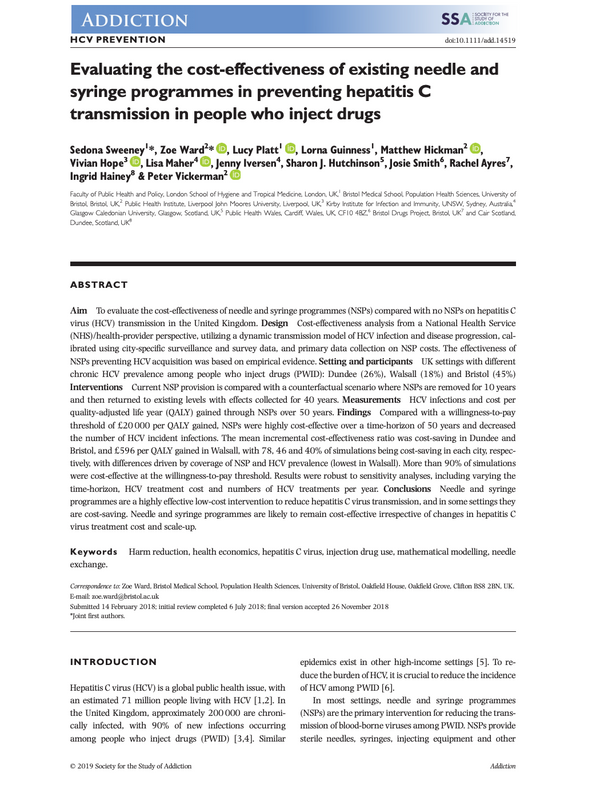Evaluación de la relación entre coste y eficacia de los programas existentes de agujas y jeringas para prevenir la transmisión de la hepatitis C entre personas que se inyectan drogas
Las conclusiones de este estudio refuerzan las pruebas que demuestran que los programas de agujas y jeringas son intervenciones eficaces y rentables. Más información, en inglés, está disponible abajo.
By Sedona Sweeney, Zoe Ward, Lucy Platt, Lorna Guinness, Matthew Hickman, Vivian Hope, Lisa Maher, Jenny Iversen, Sharon J. Hutchinson, Josie Smith, Rachel Ayres, Ingrid Hainey & Peter Vickerman
Abstract
Aim
To evaluate the cost‐effectiveness of needle and syringe programmes (NSPs) compared with no NSPs on hepatitis C virus (HCV) transmission in the United Kingdom.
Design
Cost‐effectiveness analysis from a National Health Service (NHS)/health‐provider perspective, utilizing a dynamic transmission model of HCV infection and disease progression, calibrated using city‐specific surveillance and survey data, and primary data collection on NSP costs. The effectiveness of NSPs preventing HCV acquisition was based on empirical evidence.
Setting and participants
UK settings with different chronic HCV prevalence among people who inject drugs (PWID): Dundee (26%), Walsall (18%) and Bristol (45%)
Interventions
Current NSP provision is compared with a counterfactual scenario where NSPs are removed for 10 years and then returned to existing levels with effects collected for 40 years.
Measurements
HCV infections and cost per quality‐adjusted life year (QALY) gained through NSPs over 50 years.
Findings
Compared with a willingness‐to‐pay threshold of £20 000 per QALY gained, NSPs were highly cost‐effective over a time‐horizon of 50 years and decreased the number of HCV incident infections. The mean incremental cost‐effectiveness ratio was cost‐saving in Dundee and Bristol, and £596 per QALY gained in Walsall, with 78, 46 and 40% of simulations being cost‐saving in each city, respectively, with differences driven by coverage of NSP and HCV prevalence (lowest in Walsall). More than 90% of simulations were cost‐effective at the willingness‐to‐pay threshold. Results were robust to sensitivity analyses, including varying the time‐horizon, HCV treatment cost and numbers of HCV treatments per year.
Conclusions
Needle and syringe programmes are a highly effective low‐cost intervention to reduce hepatitis C virus transmission, and in some settings they are cost‐saving. Needle and syringe programmes are likely to remain cost‐effective irrespective of changes in hepatitis C virus treatment cost and scale‐up.
